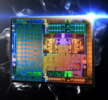AMD Radeon R4 (Stoney Ridge) vs AMD Radeon R7 (Bristol Ridge)
AMD Radeon R4 (Stoney Ridge)
► remove from comparison
The AMD Radeon R4 (Stoney Ridge) is an integrated graphics adapter of the weaker mobile dual-core Stoney Ridge APUs. At its launch, it is being used in the AMD A6-9210 and probably has 192 shaders running at up to 600 MHz. The performance can vary heavily depending on the configured TDP and the system memory.
Architecture and Features
The Radeon R5 is equipped with three cores from the third GCN generation (often called GCN 1.2 or 2.0 by the press). This means it is very similar to the Tonga desktop chip and supports DirectX 12 (FL 12_0), but the graphics cores can also be accessed via Mantle, OpenGL, and OpenCL. The GPU supports the HSA 1.0 standard as well and can therefore use the connection with the CPU cores very efficiently. The technical specifications are identical to the Carrizo predecessor.
The video unit includes the UVD 6 (Unified Video Decoder), which can decode HEVC/H.265 and 4K with support from the hardware. More details are available in our dedicated Stoney Ridge article.
Power Consumption
Depending on the model and configured TDP (cTDP), the 28 nm chip is specified with 10 up to 15 Watts. This means it can also be used for thin and light notebooks.
AMD Radeon R7 (Bristol Ridge)
► remove from comparison
The AMD Radeon R7 (Bristol Ridge) is an integrated graphics card for the fastest mobile AMD Carrizo APUs. At its launch, the R7 is available on the top model FX9830P with 512 GCN shader units and a core clock of 900 MHz. The technical specifications do not differ from the AMD Radeon R7 in Carrizo, but the clock is up to 100 MHz higher. Depending on the cooling and the configurable TDP (12-45 Watts), the performance can differ quite a lot. The performance also depends on the memory (best performance with dual-channel DDR4).
Architecture and Features
According to AMD, the Radeon R7 consists of eight cores based on the third GCN generation (often called GCN 1.2 or 2.0 in the press). It is therefore very similar to the Tonga desktop chip and supports DirectX 12 (FL 12_0). Furthermore, its shaders can be used with Mantle, OpenGL and OpenCL. HSA 1.0 is supported for running code on both CPU and GPU cores simultaneously.
Compared to the Kaveri generation (Kaveri R7 with GCN 1.1), the new color compression in particular results in better memory utilization and improves the gaming performance by 5-7 %.
The improved video decoder of Carrizo/Bristol Ridge now includes UVD 6 (Unified Video Decoder), which can decode HVEC / H.265 up to 4K in hardware. Furthermore, the VCE (Video Codec Engine) has been improved for faster transcoding of H.264. More information on architecture and features of the Bristol Ridge architecture can be found in our launch article.
Performance
Depending on the configurable TDP of the Bristol Ridge chips between 12 up to 45 Watts, there can be significant differences in games. Overall, the results are slightly better compared to the Carrizo Radeon R7 due to the higher clocks for comparable model. You can still use the Kaveri R7 benchmarks to check the gaming performance.
Power Consumption
Depending on the configurable TDP (cTDP), the 28 nm chip is specified at 12-45 Watts. It can therefore be used for thin and light notebooks as well as medium-sized devices or All-in-Ones (AiO).
| AMD Radeon R4 (Stoney Ridge) | AMD Radeon R7 (Bristol Ridge) | |||||||||||||||||||||||||||||||
| Radeon R (Stoney / Bristol Ridge) Series |
|
| ||||||||||||||||||||||||||||||
| Codename | Stoney Ridge | Bristol Ridge | ||||||||||||||||||||||||||||||
| Architecture | GCN 1.2/2.0 | GCN 1.2 | ||||||||||||||||||||||||||||||
| Pipelines | 192 - unified | 512 - unified | ||||||||||||||||||||||||||||||
| Core Speed | 600 (Boost) MHz | 900 (Boost) MHz | ||||||||||||||||||||||||||||||
| Memory Bus Width | 64 Bit | 64/128 Bit | ||||||||||||||||||||||||||||||
| Shared Memory | yes | yes | ||||||||||||||||||||||||||||||
| API | DirectX 12 (FL 12_0), OpenGL 4.4 | DirectX 12 (FL 12_0), OpenGL 4.4 | ||||||||||||||||||||||||||||||
| Power Consumption | 15 Watt | 12-45 Watt | ||||||||||||||||||||||||||||||
| technology | 28 nm | 28 nm | ||||||||||||||||||||||||||||||
| Features | UVD 6, VCE | UVD 6, VCE | ||||||||||||||||||||||||||||||
| Date of Announcement | 01.06.2016 | 01.06.2016 | ||||||||||||||||||||||||||||||
| Transistors | 2.4 Billion | |||||||||||||||||||||||||||||||
| Notebook Size | medium sized |
|
| ||||||||||||||||||||||||||||||||||||||||||||||||
Benchmarks
3DM Vant. Perf. total + AMD Radeon R4 (Stoney Ridge)
Cinebench R15 OpenGL 64 Bit + AMD Radeon R4 (Stoney Ridge)
GFXBench T-Rex HD Offscreen C24Z16 + AMD Radeon R4 (Stoney Ridge)
Average Benchmarks AMD Radeon R4 (Stoney Ridge) → 100% n=28
Average Benchmarks AMD Radeon R7 (Bristol Ridge) → 165% n=28
* Smaller numbers mean a higher performance
1 This benchmark is not used for the average calculation
Game Benchmarks
The following benchmarks stem from our benchmarks of review laptops. The performance depends on the used graphics memory, clock rate, processor, system settings, drivers, and operating systems. So the results don't have to be representative for all laptops with this GPU. For detailed information on the benchmark results, click on the fps number.

Hunt Showdown
2020
Escape from Tarkov
2020
Need for Speed Heat
2019
Borderlands 3
2019
Dirt Rally 2.0
2019
Far Cry New Dawn
2019
Metro Exodus
2019
Apex Legends
2019
Just Cause 4
2018
Darksiders III
2018
Farming Simulator 19
2018
Monster Hunter World
2018
X-Plane 11.11
2018
Ark Survival Evolved
2017
Team Fortress 2
2017
Dirt 4
2017
Rocket League
2017
For Honor
2017
Resident Evil 7
2017
Dishonored 2
2016
Titanfall 2
2016
Farming Simulator 17
2016
Battlefield 1
2016
Civilization 6
2016
Overwatch
2016
The Division
2016
Far Cry Primal
2016
XCOM 2
2016
Rainbow Six Siege
2015
Just Cause 3
2015
Anno 2205
2015
World of Warships
2015
Metal Gear Solid V
2015
Dota 2 Reborn
2015
The Witcher 3
2015
Dirt Rally
2015
GTA V
2015
Battlefield Hardline
2015
F1 2014
2014
Alien: Isolation
2014
Sims 4
2014
GRID: Autosport
2014
Thief
2014
Battlefield 4
2013
Company of Heroes 2
2013
Metro: Last Light
2013
BioShock Infinite
2013
Tomb Raider
2013
Dead Space 3
2013
Counter-Strike: GO
2012
Diablo III
2012
Anno 2070
2011
Batman: Arkham City
2011
Dirt 3
2011
StarCraft 2
2010Average Gaming AMD Radeon R4 (Stoney Ridge) → 100%
Average Gaming 30-70 fps → 100%
Average Gaming AMD Radeon R7 (Bristol Ridge) → 166%
Average Gaming 30-70 fps → 174%
For more games that might be playable and a list of all games and graphics cards visit our Gaming List













































